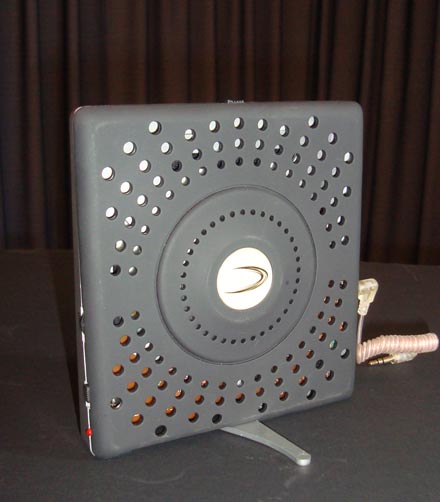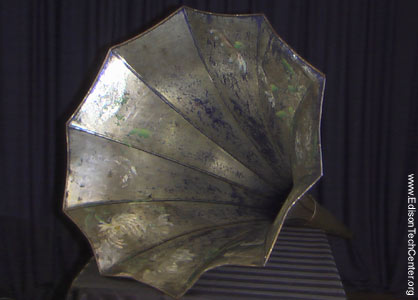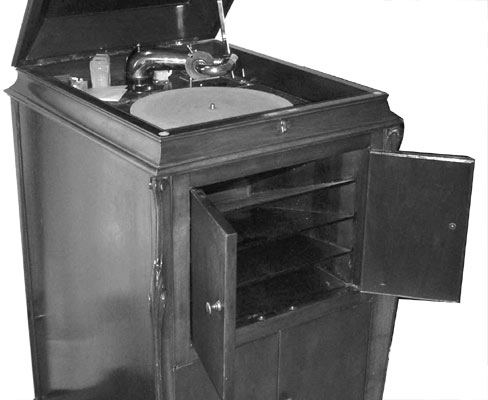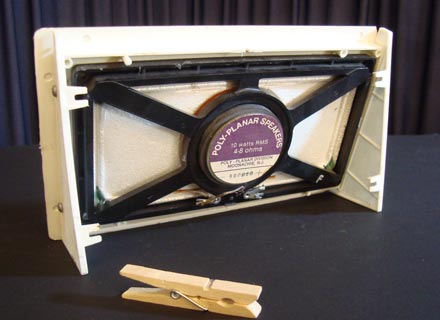Computer speaker
From Wikipedia, the free encyclopedia

A pair of speakers for notebook computers that are powered and audio-connected to the computer via USB
Computer speakers, or
multimedia speakers, are
speakers
external to a computer, that disable the lower fidelity built-in
speaker. They often have a low-power internal amplifier. The standard
audio connection is a 3.5 mm (approximately 1/8 inch) stereo
phone connector often color-coded lime green (following the
PC 99 standard) for computer
sound cards. A few use an
RCA connector for input. There are also
USB speakers which are powered from the 5
volts at 500 milliamps provided by the USB port, allowing about 2.5 watts of output power. Computer speakers were introduced by
Altec Lansing in 1990.
[1]
Computer speakers range widely in quality and in price. The computer
speakers typically packaged with computer systems are small, plastic,
and have mediocre sound quality. Some computer speakers have
equalization features such as bass and treble controls.
The internal amplifiers require an external power source, usually an
AC adapter.
More sophisticated computer speakers can have a subwoofer unit, to
enhance bass output, and these units usually include the power
amplifiers both for the bass speaker, and the small satellite speakers.
Some
computer displays have rather basic speakers built-in.
Laptops come with integrated speakers. Restricted space available in laptops means these speakers usually produce low-quality sound.
For some users, a lead connecting computer sound output to an
existing stereo system is practical. This normally yields much better
results than small low-cost computer speakers. Computer speakers can
also serve as an economy amplifier for
MP3 player use for those who wish to not use
headphones, although some models of computer speakers have headphone jacks of their own.
Common features

A common computer icon representing a speaker
Features vary by manufacturer, but may include the following:
- An LED power indicator.
- A 3.5 mm headphone jack.
- Controls for volume, and sometimes bass and treble.
- A remote volume control.
Cost-cutting measures and technical compatibility
In order to cut the cost of computer speakers (unless designed for
premium sound performance), speakers designed for computers often lack
an
AM/
FM tuner and other built-in sources of audio. However, the male 3.5 mm plug can be jury rigged with female 3.5 mm TRS
phone connector to female stereo RCA adapters to work with stereo system components such as
CD/
DVD-Audio/
SACD players (although computers have CD-ROM drives of their own with audio CD support),
audio cassette players, turntables, etc.
Despite being designed for computers, computer speakers are
electrically compatible with the aforementioned stereo components. There
are even models of computer speakers that have stereo RCA in jacks.
History
and Types of Loudspeakers
The
standard dynamic loudspeaker that we know of today was developed
in the 1920's and uses a magnetic field to move a coil or magnet which
is connected to a diaphragm. There are other kinds of speakers/sound
amplification devices besides the standard round speaker, in this article
we cover just a few of the entire list: Horns, Piezoelectric
speakers, Magnetostrictive speakers, Electrostatic Loudspeakers,
Ribbon and Planar Magnetic Loudspeakers, Bending Wave Loudspeakers,
Flat Panel Loudspeakers, Heil Airl Motion Transducers, Plasma
Arc Speakers, and Digital Loudspeakers.
The dynamic loudspeaker in the photo above outperforms many other types
of speakers, and is lower cost to produce. For these reasons it is the
most popular. We will outline some other types in this page.
1.
Horns
2. Electrodynamic Loudspeaker & about sound
3. Flat Panel Speakers: planar,
electrostatic
4. Diaphragm Speakers
5. Plasma Arc Speakers
6.
Piezoelectric Speakers
 |
Horns
were the earliest form of amplification. Horns do not use
electricity. Thomas Edison, Magnavox, and Victrola all developed
advanced and well-performing horns from 1880 to the 1920's. The
problem with horns is that they could not amplify the sound very
much. With the use of electrical amplification in the future loud
sound could be generated to fill large public spaces. Horns remain
a novelty for collectors today.
Horn
uses: Audio Recording for entertainment and recorded keeping,
later on for voice radio

Above
a straight copper horn used with wax cylinders.
|
Above:
Left: An Edison horn made from strips of tin Right:
a small straight brass horn and wax cylinder phonograph, this
type was manufactured by Edison's companies until 1913. It was
replaced by the record. The smaller horn was used in smaller rooms
of the home.
|
The
needle moves up and down and forces the metal device above it to vibrate
on the clear diaphragm (similar to a speaker). This vibration pushes
air and makes a small amount of sound. This sound is channeled in the
brass arm down under the Victrola to a wooden horn inside the box (right
photo). The horn amplifies the sound to an impressive level. Opening
or closing the wood doors on the front controls loudness by blocking
the horn inside.
Video
Below: Steve Ainlay speaks into a horn to record onto a wax cylinder:
The
horn and loud speaker development were pushed forward by the advent
of voice radio:
Left:
Pre-1925: The first voice radios
used a horn, and very quickly the horn was replaced by the electrodynamic
loudspeaker invented in Schenectady at General Electric. (WGY Radio
Station)
Right: 1927: Ernst Alexanderson
- inventor of broadcast television tests the first television broadcast
from the GE plant to his home. To his right you will see a standard
radio of the time used for the audio.
|
2.
The Electrodynamic Loudspeaker (The Modern Speaker)
|

What
is an electrodynamic loudspeaker? A:
This is a device that uses an electromagnetic coil and diaphragm to
create sound. This is the most common type of speaker in the world today.
How
does it work?
The modern speaker uses an electromagnet to turn electric signals of
varying strength into movement. The coil of copper wire moves as the
magnet energizes. This works using induction.
The coil is connected to a cardboard/paper/vinyl "cone". The
cone is a diaphragm that vibrates along with the coil. Sound is created
and amplified by the diaphragm. There are variations on how to build
the speaker. A given speaker is designed to produce a specific frequency
range. Not all materials and construction designs produce all sounds
the same: see tweeter, mid-range, woofer, subwoofer.
Why
did it take so long to invent the speaker?
It sounds simple, but to build a speaker one needs to have an understanding
of electricity, radio, sound waves, mechanics, chemistry and physics.
Today an engineer is trained after a few years of college in these areas
if they choose. Back in the early part of the 20th century the basic
knowledge of math and frequencies was still being explored. While the
electromagnet part of the speaker was invented early on in the 1860s,
it took 40 more years to develop a knowledge of acoustics and materials.
C.W. Rice and E.W. Kellogg finally invented it by solving the final
part of the puzzle. The final work was on how to shape the diaphragm
and what materials to use. The recent developments in vacuum tubes in
the 1910s helped to do sophisticated control of frequencies and power
regulation.
About
Sound:
Sound is a form of energy passing through a gas or liquid medium. Understanding
sound is in the realm of physics.
There
are two main measurements in sound: frequency and decibels.
Frequency
is responsible for the quality of sound in a speaker, decibels
measure the 'loudness' of the speaker.
Frequency:
Humans can hear audio from 20 - 20,000 Hertz. Hertz is a measure of
cycles per second. Sound is is a wave ranging from 0 level of energy
to infinity.
A
middle 'C' tone on an instrument is not a solid constant level of energy
is it sounds to our ears, it is a wave which peaks every 278 times per
second.
The
human ear does NOT hear all frequencies with the same sensitivity. It
is most sensitive to 2000 - 4000 Hz range. So a 100 dB (loudness level)
sound at 20 Hz will not damage the ear as much as a sound at 3000 Hz.
Most sounds fall in the lower range of our audible frequency range,
however sounds at 16,000 or 20,000 Hz are important. These upper frequencies
give us other information about a sound, such as the environment of
the sound. If someone is speaking in a small room or auditorium we can
tell thanks to the high frequencies. Developing a speaker which could
reproduce the low and very high frequencies was the greatest final challenge
in inventing the speaker. Of course since 1921 the speaker's abilities
to reproduce frequencies got even better.
Decibels:
The other measure of sound which is important for a speakers performance
is the loudness measured in decibels (dB). Decibels measure sound pressure.
The higher the pressure, the more your eardrum pushes inward. Decibels
is a logarithmic unit, which means that each unit indicates an increase
in power by x10. The 'bel' in decibel originates from telecommunications
pioneer Alexander Graham Bell. The need to measure sound efficiency
in gave rise to the unit in 1923.
0 dB is set at .0002 microbar (pressure). 120 dB is enough to cause
permanent damage to the human ear, however the ear will be more easily
damaged at the 2-4kHz range. This aspect of the human body being more
sensitive to certain frequencies is related to the species evolution.
A baby's cry is located in the 4-5 kHz range. We are programed to be
sensative to a baby's cry and human's scream. Similarly when we talk
about the electric light, the human eye is more sensitive to frequencies
in the green-yellow spectrum. You can read all about the development
of the electric light on our page here.
Timeline
of the Modern Speaker:
1861
- A simple type of electronic loudspeaker was developed
by Johann Philipp Reis - a teacher at Friedrichsdorf, Germany.
The speaker was crudely able to reproduce sound and just an experiment.
1876
- Alexander Graham Bell also tried to produce a speaker
based on Reis's work.
1877 - The idea of the electromagnetic
coil driven speaker is formulated by Werner Von Siemens, he used
it with input signals of DC transients and telegraphic signals. He had
no way to amplify sound to create a useful speaker, but he theorized
that this could eventually be done.
1877-1921
- Various inventors and engineers played with the idea of
the electrodynamic loudspeaker but could only create rough distorted
sounds. There was no way to electrically amplify the signal to create
very loud sounds. The industry continued to rely on more advanced horns
to create amplification.
1921
The
first modern loudspeaker
Above:
The first prototype loudspeaker, finished in May 1921. The speaker cone
is damaged. Inside the cabinet is a groundbreaking power amplification
system.
C.W.
Rice of General Electric and E.W. Kellogg of AT&T worked together
in Schenectady, New York to develop the modern speaker and first electric
amplification system. They created a working prototype in 1921. Rice
and Kellogg solved the final problems which led to a nice crisp sound.
Previous attempts to make the loudspeaker created an unacceptable muffled
sounding audio. This muffled sound was not good enough to compete with
the horn which was well established in the market. Rice and Kellogg
were able to fully understand the reproduction of all the frequencies
necessary to create an accurate audio sound. Their prototype had enough
of a dynamic range in frequencies to be better than the horn, while
possessing the ability to greatly increase loudness (dB). In 1925
they filed for patents and made a speech in St. Louis to the AIEE. After
several years of work they perfected it as the first commercial product
of it's kind called the Radiola Loudspeaker #104. It sold in 1926 for
$ 250 (about $3000 today (US dollars)). The speaker was produced under
the company name of RCA.

Above:
The first speaker. The coil was stationary unlike modern speakers, the
moving magnet was inside. Copper wires were insulated with cloth. This
prototype was built by C.W. Rice and E.W. Kellogg in 1921. The speaker
worked, but needed improvement to make it smaller so it could fit into
radio sets. Within a few years they improved the speaker so it could
fit into a radio 20 x 12 x 16" high.
 An
early speaker in a household radio,
An
early speaker in a household radio,
it uses a simple cardboard cone and small amplifier (the transformer)
|
RCA:
The Radio Corporation of America sold the first speaker
instead of General Electric because the RCA was created as a consortium
of many US companies. RCA was created under pressure from the
US government as a way of having the major electric technology
companies work together on patents in order to more easily create
finished products which could compete with state-sponsored European
companies. European companies like Philips and Siemens had a leadership
which could easily mobilize patents for creation of products.
Under the more true capitalist systems in the US at the time,
companies fought over patent royalties and kept secrets from each
other.
|
RCA was
able to collectivize research in order to create better technology.
In addition to having a strong US company to compete internationally
in the radio market, having better technology was important for the
US during escalating war tensions prior to WW2. World War 1 taught the
important lesson not to be left behind, and that radio technology could
mean the difference between winning or being crushed.
Watch
the video below to see the first prototype of the first loudspeaker:
The
electrodynamic loudspeaker today comes in several types in order to
produce a quality sound for a given frequency range:
Tweeter
- 2kHz - 20kHz. used to produce all high end frequencies. There
are many ways to construct a tweeter today. Most are electrodynamic
(magnetic) speakers however there are piezo-electric, electrostatic
and plasma tweeters.
Mid-range
Speaker - 300 - 5kHz. This speaker covers most human voice along
with most instruments.
Woofer
- 40 - 1 kHz. low frequencies. The woofer goes back to work done in
the 1930s at Bell Labs.
Subwoofer
- 20 - 200 Hz. very low frequencies. The human ear can only hear down
to 20Hz. low frequency sound is unidirectional. This means that it can
be placed anywhere in a room and be heard from any point with the same
sound quality. Subwoofers also produce sound waves that penetrate walls
easily. Noise from this type of speaker is even known to penetrate vertically
through 5+ floors of concrete apartment buildings. Needless to say it
is easy to get in trouble with local noise ordinances. If you plan your
next loud event you may want to think about frequencies and the ability
of objects to absorb/stop or reflect sound. Subwoofers were developed
in the 1960s.
Back
to Top
Flat
Panel Speakers use voice coils or other apparatus mounted to flat
panels to act as the source of sound. The flat panel acts as a diaphragm.
Below are some examples of different designs. Different materials can
be used as a diaphragm, from vinyl to Styrofoam. This is different from
a diaphragm speaker in that the moving voice coil is not wrapped around
the same material as the flat panel. The panel part is adhered to the
coil assembly.
Standard
flat panel electrodynamic loudspeaker have been difficult to make because
it is difficult to vibrate the entire flat surface evenly while creating
good frequency response. Thus other speaker types have evolved to try
to make a flat speaker.
Types
of flat panel speakers: ribbon speaker, planar magnetic, electrostatic
 |
 |

|
 |
Planar
magnetic speaker: Has a conductor attached/embedded in the
diaphragm of styrofoam. The diaphragm moves forward and backward
to make sound. This type of speakers works better than a standard
flat electrodynamic loudspeaker because the entire styrofoam flat
surface moves easily.
|
|
 |
 |
Electrostatic
flat panel speaker (no photos yet):
The
electrostatic flat panel speaker uses two metal grids with a diaphragm
made of a plastic sheet. The sheet is coated with graphite which is
electrically conductive. The diaphragm has a constant charge, high voltage
audio signal is created by the grids which are really electrodes.
It
has poor bass response but the speakers look interesting as a rectangular
flat screen. If combined with a regular electrodynamic woofer it can
be made into a full sound system.
Diaphragm
Speakers. This speaker is related to the electrodynamic loudspeaker
in that it uses magnetic fields to move an element, however its shape
is different. This speaker has the coil directly mounted on the diaphragm.
Below is an example of a flat panel style diaphragm speaker.
The copper coils have been wrapped around the base of the clear plastic
bulges in the photos below. The entire clear plastic sheet below moves
to create sound. See the diagram below. This is a heavier speaker than
the flat panel speakers above.

Plasma is
ionized gas, or current sent through a gas. Plasma is responsive to
electrical fields, therefore you can turn electric signal of sound into
an electric field which manipulates the plasma. The plasma does have
mass and will vibrate creating sound similar to how a diaphragm moves
air to make sound. This kind of speaker is visually quite interesting
but limited in sound quality. The speaker has reliability problems and
therefore remains just a novelty.
6.
Piezoelectric Speakers
|
Piezoelectric
speakers are limited in frequency response therefore they are only used
as tweeters or in small electrical devices like watches/clocks to make
simple sounds. Piezoelectronics are a solid state technology which makes
them durable and good for use as a microphone underwater. These speakers
are used as microphones in submarine warfare, they can detect other
microphones and hear sounds of other vessels.
Source :- http://simple.wikipedia.org,http://www.edisontechcenter.org,





























No comments:
Post a Comment